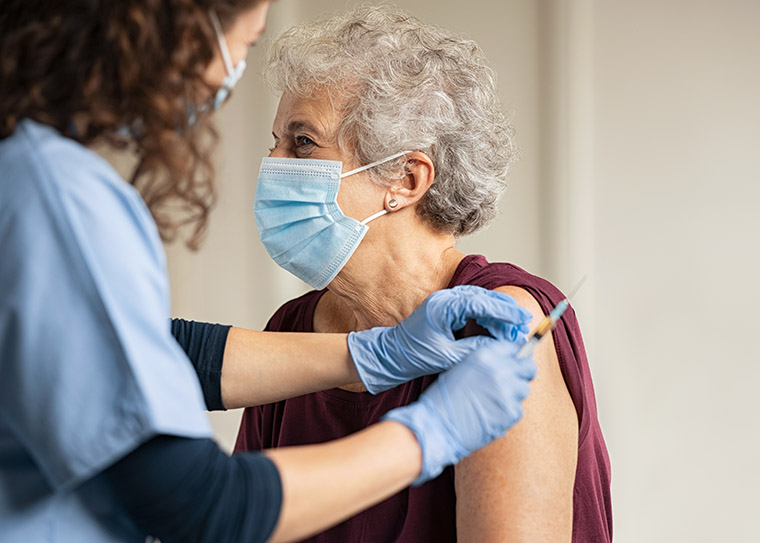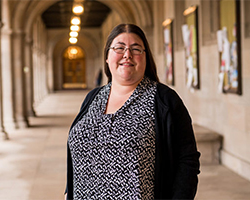Building better vaccines for the elderly: Q&A with chemist Meredith Jackrel
Approach could be relevant to COVID-19, as seniors are more susceptible

As human lifespans have gotten longer, certain proteins in our bodies are increasingly prone to take on alternative shapes. These misfolded proteins can ultimately trigger neurodegenerative diseases such as Alzheimer’s, Parkinson’s and Lou Gehrig’s disease, formally known as amyotrophic lateral sclerosis or ALS.
Meredith Jackrel, assistant professor of chemistry in Arts & Sciences, and her lab group study protein misfolding disorders. They are especially interested in how protein misfolding occurs, how it leads to disease and how scientists might be able to prevent or even reverse protein misfolding. Their expertise in the study of neurodegenerative diseases and how different protein conformations can trigger disease has made them uniquely qualified to work on the development of new vaccine technologies specifically tailored to elderly populations. Their work promises applications in flu vaccines as well as in the current coronavirus pandemic.
In this Q&A, Jackrel describes how her lab’s expertise in protein misfolding and neurodegenerative diseases has made them uniquely qualified to work on developing new amyloid-inspired vaccine technologies aimed at elderly populations.
How does your research relate to the current pandemic?
We are working on the development of new vaccine technologies specifically tailored to elderly populations. We originally initiated this project to evaluate new flu vaccine technologies, but this approach could also be relevant to COVID-19 since seniors are particularly susceptible to its severe complications.
A general problem with vaccination of elderly individuals is immuosenescence, or age-related dysfunction of the immune system. Immunosenescence is typically overcome by the addition of adjuvants to improve immune response and efficacy. However, adjuvants create local inflammation which obstructs the immune system and makes vaccines less effective.
A colleague at WashU in biomedical engineering, Jai Rudra, studies self-assembling peptides as materials for developing novel vaccines that do not require the use of adjuvants. These self-adjuvanting peptide nanofibers are hypothesized to trigger the autophagy pathway, a kind of cellular recycling that can also promote good immunological functions, which has emerged as a potential vaccine target. Administration of these peptide nanofibers leads to robust, high-affinity, and neutralizing antibody responses without local reactions, making them attractive for vaccine delivery in the elderly.
To further pursue application of these nanofibers, we must now investigate the toxicity and clearance mechanism of these materials.
How are you using your expertise in protein folding/misfolding in your work on vaccine technology?
Peptide nanofiber materials rapidly assemble into configurations that closely resemble the underlying causes of neurodegenerative disorders. These amyloids are recognized as clumps of proteins that accumulate in patients with Alzheimer’s, Huntington’s and Parkinson’s disease.
While there are key differences that we anticipate will not make use of these materials problematic, it is nonetheless essential that the safety and clearance mechanism of the peptide nanofiber vaccines be thoroughly tested. My lab’s expertise in the development of model systems to study the toxicity and mechanism of disease-associated amyloid proteins is therefore highly relevant to this project.
Furthermore, due to the complexities of studying the peptide nanofibers in mammalian cells, my lab’s expertise in the use of Baker’s yeast as a model system is proving highly relevant for studying the mechanism of clearance of these new materials.
What are your specific goals in this project?
The primary goals for my lab are to determine the toxicity and mechanism of clearance of the peptide nanofiber vaccines in a yeast model system. We aim to compare the toxicity of the nanofibers to the toxicity of disease-associated proteins. We will also employ autophagy-deficient yeast models to establish the mechanism of clearance of the nanofibers. The Rudra Lab then aims to assess the efficacy of the nanofiber-based vaccines in aged mice.
Where does the project stand now? What are the next steps?
We have established a yeast model system of these peptide nanofibers and completed much of the preliminary work. Excitingly, we have confirmed that these peptide nanofibers are not toxic in yeast and have made some new insights into their mechanism of clearance. We aim to complete the early stage of this project shortly, and the Rudra Lab has begun work in animal systems. Once we complete work with the nanofibers alone, we will begin to test conjugates to various vaccine targets, notably those that underpin COVID-19.





